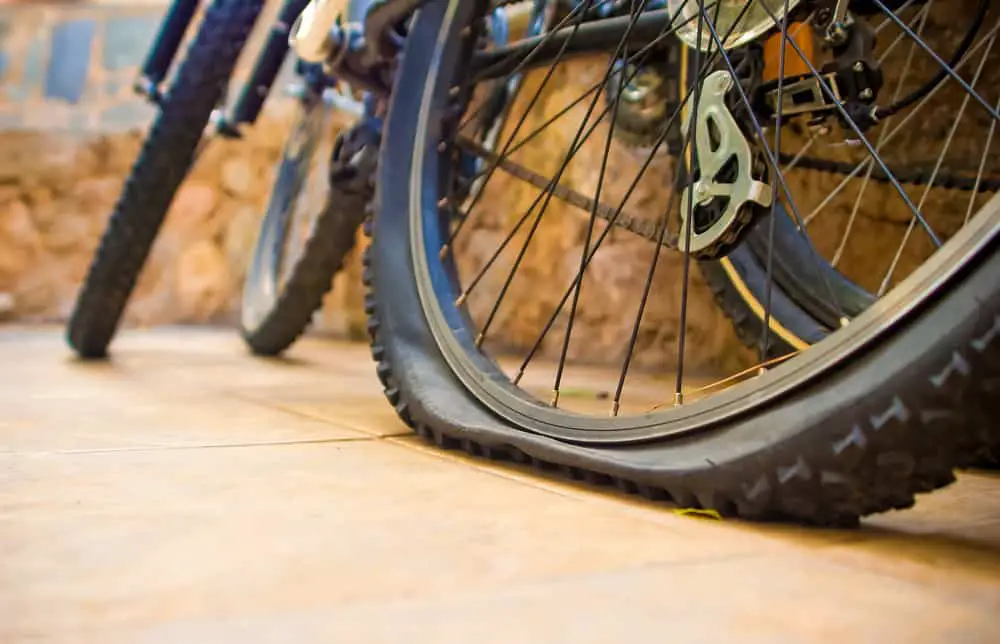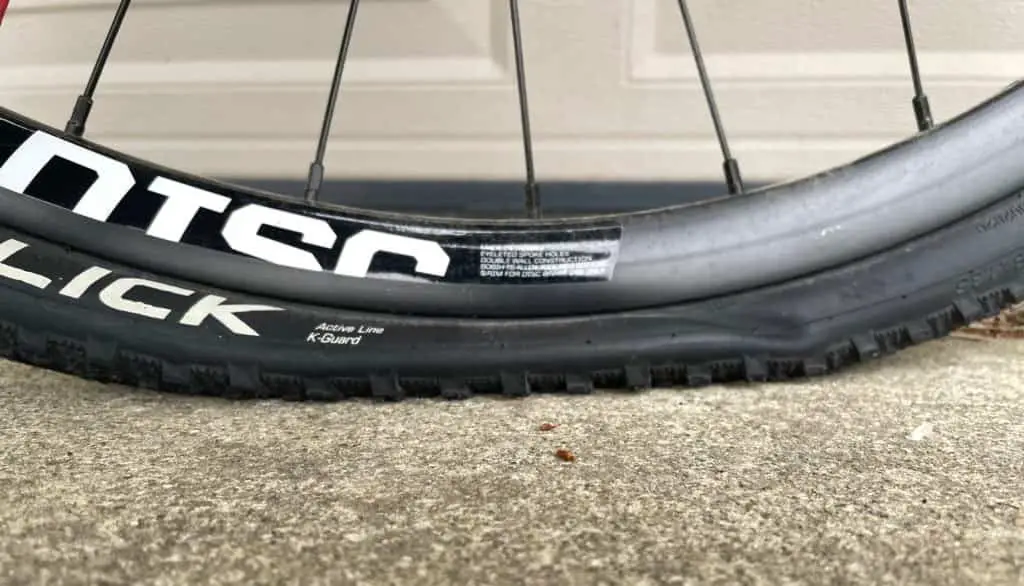Nothing ruins a bike ride like a flat tire. There’s always the urge to keep riding after your tire goes flat. But that may not be such a good idea. Let’s take a look at what could possibly happen if you try and ride on a flat tire.
Can You Ride a Bike with a Flat Tire? (Should You?)

It’s possible to ride a bike with a flat tire, but it’s not something that should be done. Riding when your tires are flat will damage not only the tire but the tire’s inner tube and rim. The tire could even come off completely, which will more than likely result in a crash and possible injury.
What Happens if You Ride on a Flat Bike Tire
While the rest of your bike will still function normally, riding on a flat tire is not advised. Several issues arise that make riding on flats a bad idea:
1. Makes Riding Difficult
First off, riding on a flat tire is no easy task. The air in your tire is a crucial factor in your bike’s ability to perform well.
Less air in your tires will increase the amount of tire surface area in contact with the ground. While letting a little air out of your tires is a great way to improve traction, letting all the air out will significantly increase rolling resistance.
Your bike will feel sluggish and unresponsive, and you’ll need to exert a lot more energy to keep your bike in motion.
2. Damages Your Tire/Tube
A punctured tire is an easy fix. But there is no saving a shredded tire.
Riding on a flat can completely destroy the tire and the inner tube. Tires are built to be durable enough to handle general wear and tear, but that’s when they’re inflated. Flat tires won’t provide enough cushioning to help the tires absorb and roll over bumps and sharp objects like rocks. Without air, the inner tubes inside are also more prone to damage.
The longer you ride on a flat, the more damage you will do to your tire and inner tube.
3. Damages Your Rims
Riding on a flat will also damage your rims. Rims are built to be stiff and responsive, but not durable enough to ride on without a tire protecting them. Not only do they perform poorly bare, but they barely perform at all. After your ride, you may end up needing to replace the entire wheel, and those are way more expensive than new tires!
Hard hits can dent and crack unprotected rims. Putting a new tire on a damaged rim is not a good idea, as the new tire can be punctured from the inside by the rim’s sharp damaged edges. Riding on exposed rims can also lead to the spokes in the wheels loosening or breaking.
If you’re a cyclist who runs tubeless tires, damage to your rims can be even worse without that extra layer of rubber (even though it’s flat) protecting your rims from the road or trail.
4. Potential to Injure Yourself
Riding on a flat tire can damage not just your bike, but you as well.
Tires are essential for providing traction. A metal rim hardly offers any grip on a road or trail. A flat tire can easily come off of the rim while you’re riding, which can cause you to lose control of your bike and crash.
The outward force of the air pressure in your tire keeps it locked onto the bead on the inside of your rim. Once your tire has lost enough air, it will no longer be secured on your wheel and may begin to pull away from the bead. If your tire isn’t secure on your wheel, it is liable to come off completely.
You may have seen this happen during a professional race or event. When a rider hits a sharp object or lands hard on a jump, their tire may rupture with a loud bang. When this happens, you’ll usually see the tire detach from the rim and hang limply from the axle like a windsock.
Crashing your bike isn’t the only way you can injure yourself. It takes a lot more energy to ride on a flat tire. You may not realize it while you’re riding, but you could be overexerting yourself and straining your muscles trying to ride on a flat tire. This pain or discomfort may not set in until a while after your ride, and you may be left wondering why you’re so sore!
5. Damages Your Bike Frame
Without the tire, your bike is missing an important shock absorber. The added pressure and tension on the bike could cause the frame to break and bend in some places.
And you don’t want to have to replace your whole bike just because of a flat tire.
But maybe you’re a risk-taker and choose to ride on your flat anyway. How far are you going to get?
How Far Can You Ride on a Flat Bike Tire

On a flat tire, you will probably be able to ride for at least a couple of miles. Honestly, you could ride a bike with no tire and still get pretty far. A wheel is a wheel after all. It won’t be easy but you can ride a flat for quite a few miles before your rim is in danger of collapsing.
Generally, how far you’re going to get on a flat tire depends on a few factors:
1. Tire Condition
The condition of your tire is one of the biggest factors influencing how far you’re going to get on your bike. The severity of your flat can make all the difference.
There are a few different types of flat tires. There are slow leaks, punctures, blowouts, pinch flats, etc. The type of flat tire you get will determine the distance you can travel.
For example, you will not get as far on a blowout (when your tire loses all of its air at once) as you will on a slow leak (when the air leaks out over a long period of time).
2. Type of Bike/ Wheel
If there is too much tension or lateral flex placed on a bike’s rim, the entire wheel can collapse.
Whether this happens or not can depend on the type of wheel you are riding on. For example, wheels made of carbon are generally stronger and stiffer than alloy wheels, which flex more easily. However, an alloy wheel with some slight bends can still be ridden on in an emergency, whereas a carbon wheel is more prone to crack during a big impact, rendering it completely destroyed.
BMX and mountain bikes have wider, stronger rims and fatter tires than road bikes. Because these bikes are made for stunts and rough terrain, their rims and tires are much more durable.
So, the more durable your rim, the farther you will get on your flat.
3. Speed
Riding fast on a flat will only accelerate the damage done to the tire. You cannot ride on a flat at the same speed that you ride on an intact tire. The faster you go, the greater potential for the wheel to give out.
You may be in a rush to get home, but riding at high speeds on a flat can be dangerous for you and your bike. Riding carefully will ensure that you get home safely and that you do as little damage to your bike as possible.
4. Terrain
What terrain you’re riding on will also affect how far you get. Some terrain can make for an easy ride home, while other terrain can damage the tire even more.
You will get the furthest riding on flat smooth ground. Rough terrain with craters, rocks, mud, hard ridges and things of that sort will make for a very challenging ride.
5. Weather Conditions
Cycling in conditions like rain, ice, or snow can be difficult on working tires. On a flat tire, these conditions are even more dangerous.
The distance you’ll get on a flat tire will be reduced significantly if you’re riding in bad weather conditions.
For example, this survey showed that 26% of cycling accidents (that weren’t collisions) were caused by ice!
Just imagine the damage if you add the reduced traction from a flat tire into the equation.
6. Bike and Rider Weight
The weight of you and your bike directly affects the rolling resistance of your tires.
So, the greater the weight your bike has to carry, the more difficult the ride.
A heavier bike can slow you down significantly. So will gaining some weight (who hasn’t experienced this!) These factors will also cause the tire to lose air more rapidly, which means you will not be getting very far.
But you don’t have to risk riding on a flat. There are plenty of alternatives.
Alternatives to Riding on a Flat Tire
1. Pack Your Roller Blades
Keep another pair of wheels on you.
If you can’t ride your bike, ride your rollerblades. It is a bit of extra weight to carry, but when you find yourself stuck on some back road miles away from home with a flat, rollerblades can get you back to civilization quickly.
2. Urban Bike Share
Bike-sharing stations are almost everywhere. If you are biking in an urban area, chances are you’ve seen rows of bikes available to rent.
These bikes are perfect for a short-distance ride to pick up a spare tube and some tools.
If you’re stuck with a flat tire near one of these stations, chain your bike up and hop on a new one. Ride to the nearest bike shop or ride home and grab your tools. Fix your flat tire and return the borrowed bike.
These bike-sharing systems are convenient and inexpensive.
3. Road Side Assistance
There are a few automotive clubs, like AAA or Better World Club, that offer roadside assistance for cyclists. These programs are available to help you repair your bike or transport you and your bike somewhere safe.
24-hours a day you can count on these programs to come to your rescue.
4. Spare Tube
The best alternative to riding on a flat tire is repairing the flat tire!
Keep a spare tube and repair kit with your riding gear for emergencies. With all the different bike bags available, storing your tools is no problem. Saddlebags, handlebar bags, frame bags, backpacks: there are plenty of places to keep a spare tube and repair kit.
It is always best to be prepared. Keeping these tools on your bike will save you a lot of trouble.
5. Walk
The most simple of solutions, get off your bike and walk it.
If you haven’t strayed too far from home, walking may be your best bet. It’s much safer than trying to continue to ride. Walk to the nearest bike shop or if you’re close enough just walk your bike home.
6. Get A Ride
Sometimes you just need to end the workout and get a ride home.
This is the safest route to take, especially if you’re far from home. Walking your bike back home or even riding on the flat could take hours depending on how far you’ve gone.
Save yourself the headache and just call a friend. The sooner you get your tire repaired the sooner you can hop back in the saddle.
